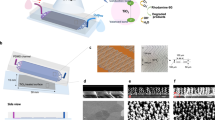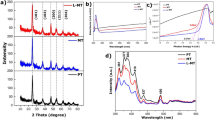Abstract
Although heterogeneous water disinfection can avoid secondary pollution and other shortcomings in homogeneous systems, its low disinfection efficiency seriously hinders its development. Here we successfully address the aforementioned issues of heterogeneous disinfection by developing discrete nanoflakes of (Al2O3@v-MoS2)/Cu/Fe3O4. Three exciting features are integrated into such a novel structure: bifacial vertically aligned nanofingerprint MoS2 grown on both sides of the light-transparent Al2O3 nanoflakes that can largely absorb sunlight, where both sides can operate simultaneously; a Cu-MoS2 junction that enhances charge separation for the efficient generation of reactive oxygen species; and magnetic Fe3O4 nanoparticles that have magnetic separation capability and conveniently regenerate after disinfection. The (Al2O3@v-MoS2)/Cu/Fe3O4 nanostructures reported herein exhibit outstanding water disinfection with thorough inactivation of over 5.7 log10 colony-forming units ml−1 Escherichia coli within 1 min in real sunlight (the system thermal effect has little impact on disinfection performances) as well as facile separation and stable long cycle reuse, demonstrating broad application prospects.
This is a preview of subscription content, access via your institution
Access options
Subscribe to this journal
Receive 12 digital issues and online access to articles
$99.00 per year
only $8.25 per issue
Buy this article
- Purchase on Springer Link
- Instant access to full article PDF
Prices may be subject to local taxes which are calculated during checkout




Similar content being viewed by others
Data availability
All data of this study are presented in the article and its supplementary information. Source data are provided with this paper. The source data and relevant data that support the findings can also be accessed through the figshare repository and are freely available for download (https://doi.org/10.6084/m9.figshare.22094465).
References
Ferraro, P. J. & Prasse, C. C. Reimagining safe drinking water on the basis of twenty-first-century science. Nat. Sustain. 4, 1032–1037 (2021).
Chu, C., Ryberg, E. C., Loeb, S. K., Suh, M.-J. & Kim, J.-H. Water disinfection in rural areas demands unconventional solar technologies. Acc. Chem. Res. 52, 1187–1195 (2019).
World Health Organization. Waterborne disease related to unsafe water and sanitation. http://www.who.int/sustainable-development/housing/health-risks/waterborne-disease/en/ (2018).
Chen, Y. et al. Advanced oxidation processes for water disinfection: features, mechanisms and prospects. Chem. Eng. J. 409, 128207–128228 (2021).
La Rosa, G., Bonadonna, L., Lucentini, L., Kenmoe, S. & Sufredini, E. Coronavirus in water environments: pccurrence, persistence and concentration methods—a scoping review. Water Res. 179, 115899 (2020).
Bogler, A. et al. Rethinking wastewater risks and monitoring in light of the COVID-19 pandemic. Nat. Sustain. 3, 981–990 (2020).
Mathieu, J., Yu, P., Zuo, P., Da Silva, M. L. B. & Alvarez, P. J. J. Going viral: emerging opportunities for phage-based bacterial control in water treatment and reuse. Acc. Chem. Res. 52, 849–857 (2019).
Zhang, J. L. et al. Guanidyl-functionalized graphene/polysulfone mixed matrix ultrafiltration membrane with superior permselective, antifouling and antibacterial properties for water treatment. J. Colloid Interface Sci. 540, 295–305 (2019).
Chen, W. et al. Silver nanowire-modified filter with controllable silver ion release for point-of-use disinfection. Environ. Sci. Technol. 53, 7504–7512 (2019).
Lee, H. R. et al. Antimicrobial effects of microwave plasma-activated water with skin protective effect for novel disinfectants in pandemic era. Sci. Rep. 12, 5968–5981 (2022).
Zhang, S. H., Ye, C. S., Lin, H. R., Lv, L. & Yu, X. UV disinfection induces a VBNC state in Escherichia coli and Pseudomonas aeruginosa. Environ. Sci. Technol. 49, 1721–1728 (2015).
Atkinson, A. J., Apul, O. G., Schneider, O., Garcia-Segura, S. & Westerhoff, P. Nanobubble technologies offer opportunities to improve water treatment. Acc. Chem. Res. 52, 1196–1205 (2019).
Pak, G. et al. Comparison of antibiotic resistance removal efficiencies using ozone disinfection under different pH and suspended solids and humic substance concentrations. Environ. Sci. Technol. 50, 7590–7600 (2016).
Yan, H. et al. Recyclable and reusable direct Z-scheme heterojunction CeO2/TiO2 nanotube arrays for photocatalytic water disinfection. Appl. Catal. B 291, 120096–120104 (2021).
Hindiyeh, M. & Ali, A. Investigating the efficiency of solar energy system for drinking water disinfection. Desalination 259, 208–215 (2010).
McGuigan, K. G. et al. Solar water disinfection (SODIS): a review from bench-top to roof-top. J. Hazard. Mater. 235–236, 29–46 (2012).
Matsunaga, T., Tomoda, R., Nakajima, T. & Wake, H. Photoelectrochemical disinfection of microbial cells by semiconductor powders. FEMS Microbiol. Lett. 29, 211–214 (1985).
Fernandez-Ibanez, P. et al. Solar photocatalytic disinfection of water using titanium dioxide graphene composites. Chem. Eng. J. 261, 36–44 (2015).
Du, J. et al. Uncovering the mechanism of novel AgInS2 nanosheets/TiO2 nanobelts composites for photocatalytic remediation of combined pollution. Appl. Catal. B 259, 118062 (2019).
Ma, S. L., Zhan, S. H., Jia, Y. N., Shi, J. & Jia, Q. X. Enhanced disinfection application of Ag-modified g-C3N4 composite under visible light. Appl. Catal. B 186, 77–87 (2016).
Teng, Z. et al. Edge-functionalized g-C3N4 nanosheets as a highly efficient metal-free photocatalyst for safe drinking water. Chem 5, 664–680 (2019).
Wang, J. et al. ‘Nano Killers’ activation by permonosulfate enables efficient anaerobic microorganisms disinfection. J. Hazard. Mater. 440, 129742 (2022).
Lopez-Sanchez, O., Lembke, D., Kayci, M., Radenovic, A. & Kis, A. Ultrasensitive photodetectors based on monolayer MoS2. Nat. Nanotechnol. 8, 497–501 (2013).
Xia, F., Wang, H., Xiao, D., Dubey, M. & Ramasubramaniam, A. Two dimensional material nanophotonics. Nat. Photon. 8, 899–907 (2014).
Gong, Y. J. et al. Vertical and in-plane heterostructures from WS2/MoS2 monolayers. Nat. Mater. 13, 1135–1142 (2014).
Zhang, J. S. et al. Reversible and selective ion intercalation through the top surface of few-layer MoS2. Nat. Commun. 9, 5289–5297 (2018).
Wang, H., Yuan, H., Hong, S. S., Li, Y. & Cui, Y. Physical and chemical tuning of two-dimensional transition metal dichalcogenides. Chem. Soc. Rev. 44, 2664–2680 (2015).
Jaramillo, T. F. et al. Identification of active edge sites for electrochemical H2 evolution from MoS2 nanocatalysts. Science 317, 100–102 (2007).
Mak, K. F., Lee, C., Hone, J., Shan, J. & Heinz, T. F. Atomically thin MoS2: a new direct-gap semiconductor. Phys. Rev. Lett. 105, 136805–136808 (2010).
Liu, C. et al. Rapid water disinfection using vertically aligned MoS2 nanofilms and visible light. Nat. Nanotechnol. 11, 1098–1104 (2016).
Attri, P. et al. Generation mechanism of hydroxyl radical species and its lifetime prediction during the plasmainitiated ultraviolet (UV) photolysis. Sci. Rep. 5, 9332–9339 (2015).
Deng, J. et al. Multiscale structural and electronic control of molybdenum disulfide foam for highly efficient hydrogen production. Nat. Commun. 8, 14430–14438 (2017).
Kong, D. et al. Synthesis of MoS2 and MoSe2 films with vertically aligned layers,. Nano Lett. 13, 1341–1347 (2013).
Wang, H. et al. Electrochemical tuning of vertically aligned MoS2 nanofilms and its application in improving hydrogen evolution reaction,. Proc. Natl Acad. Sci. USA 110, 19701–19706 (2013).
Gong, Y. et al. Spatially controlled doping of two-dimensional SnS2 through intercalation for electronics. Nat. Nanotechnol. 13, 294–299 (2018).
Zhu, G. et al. Tuning thermal conductivity in molybdenum disulfide by electrochemical intercalation,. Nat. Commun. 7, 13211–13220 (2016).
Erb, R. M., Libanori, R., Rothfuchs, N. & Studart, A. R. Composites reinforced in three dimensions by using low magnetic gields. Science 335, 199–204 (2012).
Liu, C. et al. Static electricity powered copper oxide nanowire microbicidal electroporation for water disinfection. Nano Lett. 14, 5603–5608 (2014).
Bai, H. W., Liu, Z. Y. & Sun, D. D. Hierarchical ZnO/Cu ‘corn-like’ materials with high photodegradation and antibacterial capability under visible light. Phys. Chem. Chem. Phys. 13, 6205–6210 (2011).
El Badawy, A. M. et al. Surface charge-dependent toxicity of silver nanoparticles. Environ. Sci. Technol. 45, 283–287 (2011).
Gao, P., Ng, K. & Sun, D. D. Sulfonated graphene oxide-ZnO-Ag photocatalyst for fast photodegradation and disinfection under visible light. J. Hazard. Mater. 262, 826–835 (2013).
Wang, W. J. et al. Visible-light-driven photocatalytic inactivation of E. coli K-12 by bismuth vanadate nanotubes: bactericidal performance and mechanism. Environ. Sci. Technol. 46, 4599–4606 (2012).
Wang, W. J., Yu, J. C., Xia, D. H., Wong, P. K. & Li, Y. C. Graphene and g-C3N nanosheets co-wrapped elemental α-sulfur as a novel metal-free heterojunction photocatalyst for bacterial inactivation under visible-light. Environ. Sci. Technol. 47, 8724–8732 (2013).
Acknowledgements
This work was supported by the US Department of Energy, Basic Energy Sciences, Materials Sciences and Engineering Division, under contract DE-AC02-76SF00515. We acknowledge the Stanford facilities, Stanford Nanocharacterization Laboratory and Soft & Hybrid Materials for characterization. We thank A. Boehm for assistance with the biology laboratory and facilities. We thank G. Li for his help with the ICP–MS test. We also thank Y. Zhou from Shiyanjia Lab (www.shiyanjia.com) for the electron paramagnetic resonance analysis and J. Xie from Shanghai Tech University for UV photoelectron spectroscopy measurements.
Author information
Authors and Affiliations
Contributions
T.W. and B.L. contributed equally to this work. T.W. and Y.C. developed the concept. T.W., B.L. and C.L. synthesized the samples and conducted the disinfection measurements and material characterizations. T.W. completed the material synthesis. J.W. helped with the magnetic modification. A.Y. helped with the Raman measurements. K.L. and F.S. helped with the SEM and XPS measurements. Z.L. helped with the XRD measurements. J.Z. helped with the TEM measurements. G.C. analysed the data. T.W., Y.C., H.Y.H. and A.P. co-wrote the paper. All the authors discussed the whole paper.
Corresponding author
Ethics declarations
Competing interests
The authors declare no competing financial interests. Readers are welcome to comment on the online version of the paper.
Peer review
Peer review information
Nature Water thanks the anonymous reviewers for their contribution to the peer review of this work.
Additional information
Publisher’s note Springer Nature remains neutral with regard to jurisdictional claims in published maps and institutional affiliations.
Supplementary information
Supplementary Information
Supplementary Notes 1–4, Figs. 1–18, Tables 1 and 2 and References 1–10.
Rights and permissions
Springer Nature or its licensor (e.g. a society or other partner) holds exclusive rights to this article under a publishing agreement with the author(s) or other rightsholder(s); author self-archiving of the accepted manuscript version of this article is solely governed by the terms of such publishing agreement and applicable law.
About this article
Cite this article
Wu, T., Liu, B., Liu, C. et al. Solar-driven efficient heterogeneous subminute water disinfection nanosystem assembled with fingerprint MoS2. Nat Water 1, 462–470 (2023). https://doi.org/10.1038/s44221-023-00079-4
Received:
Accepted:
Published:
Issue Date:
DOI: https://doi.org/10.1038/s44221-023-00079-4



